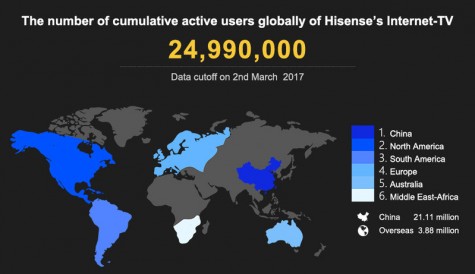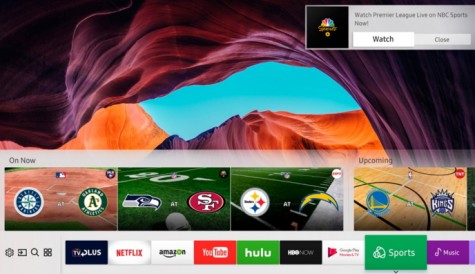
After more than 40 years of operation, DTVE is closing its doors and our website will no longer be updated daily. Thank you for all of your support.
A smart approach to Smart TV
 Connected TV is set to play a huge role in home entertainment, but industry players will need to get to grips with a broad array of legal issues, say David Naylor and Robert Blamires.
Connected TV is set to play a huge role in home entertainment, but industry players will need to get to grips with a broad array of legal issues, say David Naylor and Robert Blamires.
Internet connected TVs, or Smart TVs look set to dominate the mainstream home entertainment marketplace over the next few years – they’re already outselling games consoles, and huge rises in sales are predicted (according to Informa, 380 million people will be using them in 2015). Coupled with predictions for dramatic increases predicted for sales of in-home connected devices generally (ownership will reach 1.8 billion in 2016, according to Informa’s predictions), the commercial and legal landscape for every business in the sector is set to change fundamentally.
Until recently, the delivery of mainstream media and entertainment content to the home has largely been to ‘dumb’ terminals – televisions in the living-room essentially capable of receiving linear content only. While the advent of set-top box technology, VOD and catch-up services has begun to disrupt the traditional ‘linear only’ model, in comparison to what is coming, only to a very limited extent.
New opportunities
Smart TVs don’t just give users the freedom to view whatever they like on the web, when they want. They also give the key players in the content supply chain access to the richest source of information they have ever had on viewer behaviour and preferences. This presents a completely new set of opportunities, not only for TV manufacturers, who have previously lacked ‘ownership’ of any part of the consumer relationship (at least, after the initial purchase of the screen), but also for every business that can configure its business to become part of the value chain. This includes, for example:
• Smart TV content provider partners (like iPlayer, Lovefilm and Netflix);
• manufacturers of set-top boxes, media consoles and other hardware that enable ‘dumb TVs’ to deliver a Smart TV experience (like YouView, TiVo, Apple TV, or Sony’s PS3);
• ISPs and major online players, who are all positioning themselves to take a piece of the Smart TV viewing real estate (think Google); and
• software developers who are building Smart TV applications (for example, gesture recognition software, enabling TVs to be switched on, literally, with the flick of a hand), app stores, and complementary multi-screen services for access via tablet computers and other mobile devices, designed to be used simultaneously with Smart TV services (for example, interactive programming and social media services like Zeebox that link to and enrich the user viewing experience).
Put very simply, the industry is undergoing a seismic shift that has already enabled the creation of entirely new breeds of media and entertainment business.
It is therefore no surprise that these businesses are vying for direct access to end users and their content purchases and usage data. While the possibilities for partnering arrangements are very real and not insignificant, businesses will have to adopt a careful and strategic approach if they are to ensure they are among the winners in the battle for a share of the new revenue streams created by the connected TV market. This will not be easy in a market that is moving so rapidly.
New challenges
New opportunities, particularly opportunities at a global scale, also bring new legal challenges and responsibilities, and new compliance obligations. Since this is uncharted territory for many of those involved, plotting a course that allows legal obligations and risks to be managed effectively will demand careful thought and planning, and successful execution.
Privacy
Smart TVs are facilitating a blossoming of services associated with consumer personal data (about, for example, consumer preferences, viewing habits and transactional decisions). This will bring potentially complex domestic and cross-border compliance challenges related to privacy law and regulation.
When users access Smart TV platforms, they are likely to provide personal data, both by submitting information about themselves (such as name, address, date of birth, and sex) when they register for specific services, as well as in the sense of the data trails created about their usage of the platform (including viewing habits and preferences), in other words behavioural data. Much of this behavioural data will be collected using cookies and other behavioural monitoring technology, which has been subject to much debate, regulatory scrutiny and legislative activity in recent years, particularly in the last twelve months. Compliance in the current climate involves a balance between obtaining necessary, appropriate and informed consents while not compromising the user-experience and platform functionality.
In general, those collecting such data are likely to be “data controllers”, and therefore subject (at least in Europe) to Europe’s extensive data protection regime. The compliance obligations relate to all aspects of personal data processing, including, for example:
• processing and storage;
• transfers (particularly cross-jurisdictional), including to outsourced service providers (“data processors”);
• rights which users (as “data subjects”) have in relation to data about them;
• accuracy and security;
• how long data can be kept; and
• what data can be used for.
While compliance should not be an insurmountable obstacle for Smart TV businesses, it requires a careful, considered and strategic approach (particularly since loss or misuse of personal data can be very costly, both in the media and the courts).
Content
In many jurisdictions, the provision of media services is itself specifically regulated, even if the content is delivered over the internet. For example, in Europe “on demand” services are now regulated under the EU Audiovisual Media Services Directive, which means that regulated service providers (including any Smart TV businesses with editorial responsibility for TV-like content on their platforms) need to observe a range of requirements that govern, for example, product placement, advertising and sponsorship, and numerous content-specific rules (relating, for instance, to protecting minors and to content which might incite hatred based on race, sex, religion or nationality).
Consumers
The provision of goods and services to consumers is also heavily regulated in many jurisdictions. In Europe, not only is there generic consumer protection law applicable to all consumer transactions, but there are also specific e-commerce and ‘distance-selling’ based regulations. Taken as a whole, this area of regulation pervades every aspect of the supplier-consumer relationship. It impacts issues such as supplier limitations and exclusions of liability, taking indemnities from consumers, and other terms that imbalance the supplier-consumer relationship, while also requiring online retailers (which would include Smart TV businesses selling content to consumers) to make certain information available and, under most circumstances, to give consumers the right, for a limited period after placing an order, to cancel it and obtain a refund. There are certain exceptions to the cancellation right that might apply to Smart TV businesses; however the service needs to be structured appropriately and consumers adequately informed. In addition, there is a new regime coming into force under the new EU Consumer Rights Directive, which includes specific provisions relating to the sale of digital content and which will therefore be directly relevant to certain businesses in the Smart TV value chain.
Equality
Lastly on the subject of regulation, there are also regulatory regimes covering the accessibility of online platforms for users with disabilities. These involve a plethora of considerations such as: providing workable text equivalents of images and sounds; varying font sizes while maintaining the platform’s usability; navigating the platform without a mouse or other pointing device; and usability of the platform in grey scale.
Failure to comply
As many companies have already found, failure to comply with the complex regimes that underpin the regulatory obligations in these various areas can easily result in regulatory intervention and sanctions, legal liability, and (often most importantly) reputational damage.
Commercial arrangements and service agreements
Moving on from regulation, manufacturers of Smart TVs may never have negotiated partnering or other commercial arrangements around content-delivery, or the processing of consumer data. This will require inputs and services from numerous players such as:
• the design and implementation of user portals and interfaces, content delivery and distribution systems and app stores;
• advertising services;
• database and CRM management services;
• DRM and geo-location capabilities; and
• e-commerce and electronic payment services.
Further, if businesses want to offer their own content services, they will also need agreements with content-owners enabling the licensing of content onto the platform and potentially from it, to enable syndication and multi-platform distribution.
Understanding how these inter-related services should be integrated and deployed, the procurement terms, and the service level commitments typically offered, will be critical to any successful implementation.
User-generated content
Where users of Smart TVs are able to access and submit user generated content, this will give rise to potential legal liability; not only for users, but also for the platforms that host and provide access to such content. For example, problems often arise with content that: is defamatory; is criminal; or infringes a third party’s intellectual property rights (a typical claim by rights owners in relation to, for example, content on music and video sharing platforms).
While there are potential defences, for certain intermediaries, to many claims of this kind, they have limitations:
• they do not protect against all types of liability;
• they fall away once the intermediary becomes “involved with” the content (eg by being put on notice); and
• they do not necessarily protect all intermediaries (for example search engine providers are not necessarily covered).
Smart TV businesses should therefore carefully consider the extent to which they might be liable for content transmitted over their platforms, and take care to build and operate businesses where this risk is managed and minimised.
Conclusion
This article covers (at a high level) some of the principal issues relevant to businesses in the Smart TV value chain. Issues not covered include: the provision of Smart TV services to children (for example, the delivery of age-appropriate content and the collection of data); moderation of user-generated content; regulation of advertising; and ownership and licensing of intellectual property rights, to name but a few.
In short, companies in the Smart TV eco-system will have to address a wide array of commercial, legal and regulatory challenges while trying to build profitable, sustainable businesses in an intensely competitive and dynamic market. It is not a challenge for the faint-hearted, but the opportunities are significant.
As they say, ‘watch this space’. The smart money’s on it.
David Naylor is a partner and Robert Blamires is a senior associate in Field Fisher Waterhouse’s Technology Law Group


